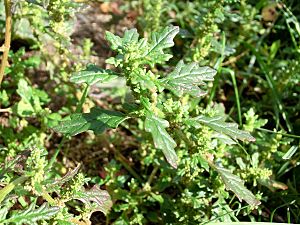Clammy goosefoot facts for kids
Quick facts for kids Clammy goosefoot |
|
|---|---|
 |
|
| Scientific classification | |
| Genus: |
Dysphania (plant)
|
| Species: |
pumilio
|
| Synonyms | |
|
Chenopodium pumilio R.Br. |
|
Dysphania pumilio is a type of flowering plant. It belongs to the Amaranthaceae family, which includes plants like amaranth and quinoa. People often call this plant clammy goosefoot because of its sticky feel.
This plant is originally from Australia. However, it has spread to many other parts of the world. You can often find it growing in places where the ground has been disturbed. This includes areas like roadsides or empty lots. It has been seen in North America and Europe. Recently, it was even found in Iran for the first time.
About Clammy Goosefoot
How It Spreads
Scientists believe that Dysphania pumilio first arrived in Europe with imports of wool from Australia. The plant's seeds might have been mixed in with the wool. This shows how plants can travel across the world.
What It Looks Like
Dysphania pumilio is an annual plant. This means it completes its entire life cycle in one year. It is also very aromatic, meaning it has a strong smell. The plant grows upright, reaching about 25 centimeters (10 inches) tall. Its stems are sticky and covered in tiny glands.
Leaves and Flowers
The leaves of the clammy goosefoot are arranged one after another along the stem. Each leaf can be up to 2 centimeters (about 0.8 inches) long. They are shaped like a spear or an oval. The edges of the leaves have small, bumpy lobes. The surface of the leaves is also covered in white, sticky glands. You might also see a few hairs on them.
The plant's flowers grow in round clusters. These clusters are found where the leaves meet the stem. The flowers themselves are very tiny and green. Each flower is bumpy and covered in glands. They grow closely together, covering the fruit as it develops.
See also
 In Spanish: Dysphania pumilio para niños
In Spanish: Dysphania pumilio para niños

